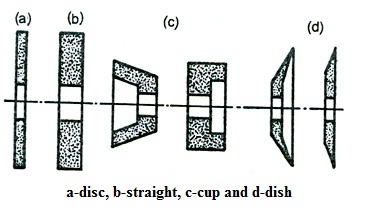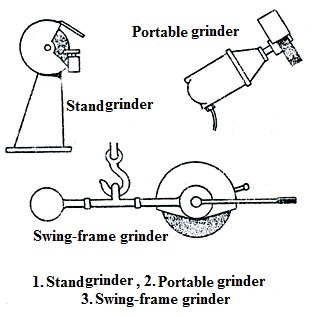Site pages
Current course
Participants
General
Topic 1
Topic 2
Topic 3
Topic 4
Topic 5
Topic 6
Topic 7
Topic 8
Topic 9
Lesson 12. INTRODUCTION TO MILLING AND GRINDING MACHINE
Lesson 12
INTRODUCTION TO MILLING AND GRINDING MACHINE
12.1 Milling
12.1.1 Introduction
Milling may be defined as a machining operation for removing excess material from a work piece with a multi-tooth rotating cutter.
Flat or curved surfaces of many shapes can be machined by milling with good finish and accuracy.
A milling machine may also be used for drilling, slotting, making a circular profile, gear cutting or helical milling with suitable attachments.
Generally the work piece is fed past the rotating cutter but sometimes feed may also be given to the cutter. The teeth of the cutter act as individual cutting edges each producing a small chip of its own.
12.2 Milling Machines
Milling machines are made in a variety of designs and sizes. They may vary in terms of the drive mechanism, method of feeding, table movements’ available number of cutters operating simultaneously etc.
12.3 Milling Machines
Knee and column type milling machines are the general purpose machines most widely used in industry. They are capable of producing flat or formed surfaces and may also be used for gear or spine cutting, helical milling,drilling, boring and slotting when provided with suitable attachments. These machines are available with vertical or horizontal spindles and may be of plain or universal type.
A plain horizontal milling machine has a rigidly supported horizontal arbor on which the cutters are mounted. The spindle of the machine is hollow, with an internal taper at the end to accurately locate the arbor or the shank of a milling cutter. Arbors are held in place by a long bolt, called draw bar. This screws into the tapered end and is fastened at the back of the machine. The knee of the machine is mounted on the column and can be adjusted or fed lengthwise on top of the saddle in the third coordinate direction. Feed may be given by hand or power. The over arm extending from the top of the column carries a support for the outer end of the arbor. Braces are available to tie the arbor support and over arm to the knee for added support. Work pieces, various attachments and milling fixtures are fixed on the table making use of the T-slots provided on the table for this purpose.

Fig. 12.1 Column and knee type milling machine
This classification of cutters is based on the general shape of the cutters or the type of work they will do.
12.4.1 Plain milling cutters
These are disc shaped cutters with teeth only on their circumference and no teeth on the sides. The teeth may be straight or helical if width exceeds 16 mm. These cutters are used for machining flat surfaces and may be called slab mills when used for slabbing work. Notches may be provided in the teeth of wide helical cutters used for heavy slabbing work to break the chips and help in their removal.
12.4.2 Side and face cutters
These cutters are similar to plain cutters except that they have teeth on one or both sides as well as on their periphery.They may have straight helical or staggered teeth. These cutters are used for machining slots with smoother or more accurate sides than those machined with plain milling cutters.
12.4.3 Sitting saws
These are thin arbor mounting cutters with a thickness of 5 mm or less. They resemble plain milling cutters with cutting edges only on the outer surface. They are used for producing narrow slots or for parting-off operations. The sides of these cutters are relieved by grinding so that the sides do not rub during use.
12.4.4 Angle milling cutters
The teeth on these cutters are cut on conical surfaces. Both single and double conical surface cutters are available. Angle cutters are used for machining dove-tails, ratchet wheels, flutes on reamers etc.
12.4.5 Form milling cutters
Cutters of this type include concave and convex cutters, gear cutters, fluting cutters and many other cutters with special contours. These cutters produce an inverse replica of the shapes of their cutting edges on the work piece. Some of these cutters like gear-tooth space cutters and flute cutters are available in standard sizes, others must be made specially for the job. It is necessary to ensure that the contour of the cutting edges of a form milling cutter is not changed when re-sharpening the cutter.
12.4.6 End mills
These are shank mounting cutters with teeth at the end as well as on the periphery. They have either straight or helical flutes. They are used for cutting slots, producing recesses, squaring ends or surfacing.
12.4.7 T-slot cutters
Cutters of this type are used for cutting T-slots. They resemble small plain milling cutters with straight or tapered shanks for holding in the spindle.
12.5 Grinding
12.5.1 Introduction
Grinding is a metal cutting operation performed by means of a rotating abrasive wheel that acts as a tool.This is generally used to finish work pieces which must show a high surface quality, accuracy of shape and dimensions. Mostly grinding is the finishing operation because it removes comparatively little metal about 0.25 to 0.50 mm in most operations and the accuracy in the dimensions is in the order of 0.000025 mm. grinding may be of two types: 1. Rough or non-precision grinding where the work is held in operator’s hand. The work is pressed hard against the wheel or vice-versa. The accuracy and surface finish obtained are of secondary importance and considerable amount of metal is removed.
2. Precision grinding which is concerned with producing good surface finish and high degree of accuracy. The wheel or work or both are guided in precise path.
12.5.2 Grinding machine
Grinding machines are of rough type or precision type. Rough grinder may be floor stand and bench grinder, portable and flexible shaft grinder, swing frame grinder or abrasive belt grinder type. Precision grinders may be cylindrical grinder, internal grinder, surface grinder, tool and cutter grinder or special grinder type.
The simplest type of grinder is the floor stand grinder with a horizontal spindle with wheels usually at both ends and is mounted on a base or pedestal. There is a provision for driving the wheel spindle by belt from motor at the rear at floor level. Frequently the wheels are mounted directly on the motor shaft extensions, where the motor is on the stand. The small size machine mounted on a bench is called bench grinder. All the grinding machines operate on the same principle but the different work holding and wheel driving mechanisms and attachments are provided to achieve desired grinding.
12.5.3 Grinding wheels
Grinding wheel is a multi-tooth cutter made up of many hard particles which do the cutting. Abrasive grains are mixed with suitable bond which acts as a matrix or holder when the wheel is in use. The abrasive wheel is usually mounted on some form of machine adopted to a particular type of work. It must be hard and tough and the wheel surface must be capable of gradually breaking down to expose new sharp cutting edges to the material being ground. The material components of a grinding wheel are the abrasive grain and the bond; however there are other physical characteristics such as grain size, structure and wheel shape must be considered in grinding wheel manufacturing and selection.
12.5.4 Abrasives
2. Artificial or manufactured : Aluminium oxid (Al2O3) known as alundum and aloxide, silicon carbide known as carborundum and crystolon.
Abrasive grains are bonded together in the form of grinding wheel generally by bonds like vitrified, resinoid, rubber, shellar, silicate and oxy-chloride,vitrified, resinoid and rubber bonds are the most common.
Grinding wheels are made indifferent shapes and sizes to adopt them for use in different types of grinding machines and on different classes of work. The shapes of the wheels may straight, cylindrical, cup, dish, segmented etc as shown below.

Fig. 12.2 Principal shapes of grinding wheels

Fig. 12.3 Rough grinding machines

Fig. 12.4 Block diagram of a tool and cutter grinder